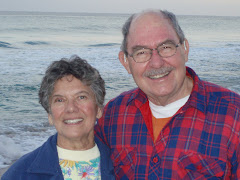Hello everybody, since our last posting we have gone into Dawson (also known as Dawson City) to see the sights. We visited the town’s historical museum, much of which dealt, as you might guess, with the town’s early gold rush days. There was also a small railroad museum with two locomotives. In the early 1900’s a group of entrepreneurs incorporated a short line, narrow gauge, railroad, developed to serve the miners. All the railroad equipment and locomotives had to be shipped to Dawson from Whitehorse by steam boat, in many cases, disassembled. The railroad was mismanaged from the beginning, but eventually went broke, because the mines mostly became consolidated into several dredging companies, requiring less labor, and a decreasing population.
We visited Jack London’s cabin. Jack London was a relatively unsuccessful miner, whose cabin was originally 40 or 50 miles from Dawson. As a nutritionist I was interested to learn he nearly died from scurvy the final year he spent in the Yukon Territory, losing all his teeth. However he capitalized on his experiences in the Yukon Territory with his many best-selling books, such as “The Call of the Wild”, and short stories, such as “To Build a Fire”. I remember reading his books when I was in my early teens, but I suppose his writing is less popular now, and dated to some extent.
We departed from Dawson, last week, taking a ferry across the Yukon (no bridge) and then over the “Top of the World” Highway. This road is part paved, partly gravel, and partly oiled but in poor repair. We did not find the road as bad as we expected. The stretches through Yukon Territory war largely over alpine tundra, above the tree line. There were spectacular views of mountains on the left and on the right. After crossing the border into Alaska, the road turns to gravel. It is mostly, but not always two lanes wide, the shoulders are very soft due to permafrost, and one needed to know exactly where one’s tires were when meeting an approaching RV or truck, to avoid sinking into the soft shoulder and getting stuck. We spent a fairly leisurely day traveling, and stopped to boondock in a very pleasant BLM campground.
The next day we took our car, and went on a side trip to the small town of Eagle, about sixty miles north, on the Yukon River. As we went on our trip we ascended to a long stretch of road in an area covered with dense brush and aspen trees. We ran into many groups of caribou --- groups consisting of two to perhaps ten animals. There were males, females, and what appeared to be both new born and year-old calves. We later learned that this was an unusual event, seeing a herd this time of year; we were probably seeing a herd, migrating because of forest fires in some area where they usually summer.
The trip to Eagle was over the Forty Mile River area, where much of the gold was discovered prior to the rich strikes in the Klondike. The small towns are gone now, and many of the early roads seemed to have disappeared, so the forest in the valleys is really wilderness now.
Eagle is a pretty little town. At one time it was the center of activity in this part of Alaska. There was an army detachment in a fort, and a custom house, to handle trade between Dawson and Eagle. Eagle was named from eagles that used to soar above the cliffs on the Yukon River. The Yukon is quite wide here, and I will post a photo of the river and the cliffs. We visited the local museum, and got a guided tour through the old courthouse, that contained many artifacts from early days. There is a BLM ranger station supervising the fort of which there are several buildings remaining and area historical site, and helping travelers to the Yukon-Charley River Wilderness. There is also an Indian village nearby, but we did not visit. Madeline asked what people did for shopping for food and clothing. The answer was, they go to Fairbanks twice a year (over two hundred miles away), and depend on gardens for produce in the summer.
We returned to our campsite, and the next day we proceeded down the road, passing by the small town of Chicken. Chicken is an old gold mining town, said to be named “Chicken”, because the original settlers wanted to call it “Ptarmigan”, after the bird, common to the area, but none could spell the word. There is a development called “Beautiful Downtown Chicken” which includes a gift shop, a liquor store, saloon, café, and two outhouses (with the name, on a sign, “chicken poop”. The ceiling of the saloon is lined with hats, with an occasional pair of panties. It is said that the panties can only be put on the ceiling, if they are taken off in front of everyone! That gives you an idea of the level of humor in Chicken ---vulgar, scatological, but funny.
From Chicken, we continued on the road, until we reached the Alaskan Highway, and we drove on a few miles to the town of Tok. We are now in a campground, the Sourdough. There is nightly entertainment – a bluegrass band of the owner and two others, followed, by a pancake tossing contest. Toss a pancake into a bucket, if it goes in, you get a free pancake breakfast. Lots of kidding and lots of fun.
Tomorrow, we go to Valdez (pronounced Valdeez).
Friday, July 27, 2007
Subscribe to:
Post Comments (Atom)

No comments:
Post a Comment